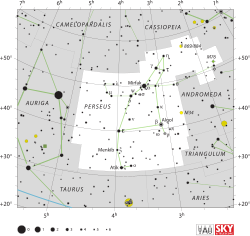Gamma Persei
| Gamma Persei (γ) | |
 | |
| Observationsdata Epok: J2000.0 | |
|---|---|
| Stjärnbild | Perseus |
| Rektascension | 03t 04m 47,79074s[1] |
| Deklination | 53° 30′ 23,1687″[1] |
| Skenbar magnitud () | +2,93[2] |
| Stjärntyp | |
| Spektraltyp | G8 III + A2V[3] |
| U–B | +0,45[2] |
| B–V | +0,70[2] |
| Variabeltyp | EA[4] |
| Astrometri | |
| Radialhastighet () | +2,5[5] km/s |
| Egenrörelse (µ) | RA: +0,51[1] mas/år Dek.: -5,92[1] mas/år |
| Parallax () | 13,41 ± 0,51[1] |
| Avstånd | 243 ± 9 lå (75 ± 3 pc) |
| Absolut magnitud () | -1,5[3] (-1,23/0,01)[6] |
| Detaljer | |
| Massa | 2,7[6] M☉ |
| Luminositet | 113,0[7] L☉ |
| Temperatur | 5 170[8] K |
| Metallicitet | -0,19[8] dex |
| Vinkelhastighet | 50,0[3] km/s |
| Andra beteckningar | |
| γ Persei, 23 Persei, BD +52 654, CCDM J03048 + 5331AP, FK5 108, GC 3664, HD 18925, HIP 14328, HR 915, IDS 02576 + 5307 AP, PPM 28201, SAO 23789, WDS J03048 + 5330Aa, Ab. | |
Gamma Persei (γ Persei, förkortat Gamma Per, γ Per) som är stjärnans Bayerbeteckning, är en dubbelstjärna belägen i den nordvästra delen av stjärnbilden Perseus. Den har en skenbar magnitud på 2,93[2] och klart synlig för blotta ögat. Baserat på parallaxmätning inom Hipparcosuppdraget på ca 13,4 mas,[1] beräknas den befinna sig på ett avstånd av ca 243 ljusår (75 parsek) från solen. Gamma Persei är utgångspunkten för det årliga meteorregnet Perseiderna.[9]
Nomenklatur
[redigera | redigera wikitext]Gamma Persei har, tillsammans med α Per, δ Per, ψ Per, σ Per, och η Per, kallats Perseussegmentet.[10]
Egenskaper
[redigera | redigera wikitext]Gamma Persei är en gul till vit jättestjärna av spektralklass G8 III[3] Den har en massa som är omkring 2,7[6] gånger större än solens massa och utsänder från dess fotosfär ca 113[7] gånger mera energi än solen vid en effektiv temperatur på ca 5 170[3] K. Den har en följeslagare med spektralklass av A3 V [6] alternativt A2 (III).[11]
Dubbelstjärnan är en förmörkelsevariabel med en omloppsperiod på 5 329,8 dygn (14,6 år).[12] Förmörkelsen, som observerades första gången 1990, varade då i två veckor.[13] Under en förmörkelse passerar primärstjärnan framför följeslagaren, vilket gör att systemets magnitud minskar med 0,55.
Källor
[redigera | redigera wikitext]- Den här artikeln är helt eller delvis baserad på material från engelskspråkiga Wikipedia, tidigare version.
Referenser
[redigera | redigera wikitext]- ^ [a b c d e f] van Leeuwen, F. (November 2007), "Validation of the new Hipparcos reduction", Astronomy and Astrophysics, 474 (2): 653–664, Bibcode:2007A&A...474..653V, arXiv:0708.1752 , doi:10.1051/0004-6361:20078357
- ^ [a b c d] Johnson, H. L.; et al. (1966), "UBVRIJKL photometry of the bright stars", Communications of the Lunar and Planetary Laboratory, 4 (99): 99, Bibcode:1966CoLPL...4...99J
- ^ [a b c d e] Malkov, O. Yu.; Tamazian, V. S.; Docobo, J. A.; Chulkov, D. A. (2012). "Dynamical masses of a selected sample of orbital binaries". Astronomy & Astrophysics. 546: A69. Bibcode:2012A&A...546A..69M. doi:10.1051/0004-6361/201219774.
- ^ Samus, N. N.; Durlevich, O. V.; et al. (2009). "VizieR Online Data Catalog: General Catalogue of Variable Stars (Samus+ 2007-2013)". VizieR On-line Data Catalog: B/gcvs. Originally published in: 2009yCat....102025S. 1. Bibcode:2009yCat....102025S.
- ^ Wilson, Ralph Elmer (1953), "General Catalogue of Stellar Radial Velocities", Washington, Washington: Carnegie Institution of Washington, Bibcode:1953GCRV..C......0W
- ^ [a b c d] Ling, J. F.; Magdalena, P.; Prieto, C. (October 2001), "Perturbations by Mass Loss in the Orbital Elements of γ Persei and α Centauri", Revista Mexicana de Astronomia y Astrofisica, 37: 179–186, Bibcode:2001RMxAA..37..179L
- ^ [a b] https://www.universeguide.com/star/gammapersei. Hämtad 2017-11-05.
- ^ [a b] McWilliam, Andrew (December 1990), "High-resolution spectroscopic survey of 671 GK giants", Astrophysical Journal Supplement Series, 74: 1075–1128, Bibcode:1990ApJS...74.1075M, doi:10.1086/191527
- ^ Burnham, Robert (1978), Burnham's celestial handbook: an observer's guide to the universe beyond the solar system, Dover books explaining science, 3 (2nd ed.), Courier Dover Publications, p. 420, ISBN 0486236730
- ^ McAlister, H. A. (March 1982), "Masses and luminosities for the giant spectroscopic/speckle interferometric binaries gamma Persei and phi Cygni", Astronomical Journal, 87: 563–569, Bibcode:1982AJ.....87..563M, doi:10.1086/113130
- ^ Ginestet, N.; Carquillat, J. M. (December 2002), "Spectral Classification of the Hot Components of a Large Sample of Stars with Composite Spectra, and Implication for the Absolute Magnitudes of the Cool Supergiant Components", The Astrophysical Journal Supplement Series, 143 (2): 513–537, Bibcode:2002ApJS..143..513G, doi:10.1086/342942
- ^ Pourbaix, D.; Boffin, H. M. J. (February 2003), "Reprocessing the Hipparcos Intermediate Astrometric Data of spectroscopic binaries. II. Systems with a giant component", Astronomy and Astrophysics, 398 (3): 1163–1177, Bibcode:2003A&A...398.1163P, arXiv:astro-ph/0211483 , doi:10.1051/0004-6361:20021736
- ^ Kaler, James B. (January 5, 2001), "GAMMA PER (Gamma Persei)", Stars, University of Illinois, hämtad 2012-02-25





